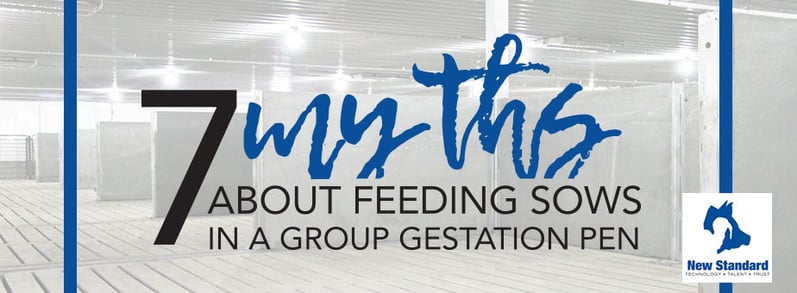
We are all aware of the pressure on producers to switch to group gestation pens, but making this transition is not an easy task. It is especially difficult when we hear horror stories and find research showing the problems that arise with feeding sows in loose pens. We want to put you at ease and tell you what it is like in a well-designed hog barn by busting some of the common myths you have probably heard about group sow housing.
1. You're going to increase your barn costs only because of animal welfare pressures
We understand the frustration of being forced to convert to group sow housing because of animal welfare issues, but it is not the only reason you should make the switch. With proper hog pen design and equipment, you will maximize feed efficiency per animal, improve sow health and improve overall performance.
2. Feeding sows in group housing leads to variation in body condition
Some loose sow housing facilities have run into problems with body condition variation, but this is typically from improper gestation pen design. With electronic sow feeding, properly applied, each pig is able to eat individually without being pressured, which ensures that they receive the appropriate ration and continue to gain weight consistently. You can also incorporate automatic weight collection to determine if animals are staying within a preset growth curve.
3. Dominant sows will force the others away from the feed stations
Even if you install ESF systems, won't the dominant sows just block the stations and force the others away? Not with the right design. ESF feeders should be designed to always open for any sow whether she has eaten or not. The identification sensors should be inside the feed station, so all sows are let through the gate and no backups occur. If the dominant sow has already eaten and comes back through, no feed will be dispensed for her. Once the system determines she does not have any available ration, she will be sent on her way but upon exit will not be anywhere near the entrance. Once the girls realize there is little value in racing back to the entrance, they soon decide not to bother but lay down instead.
4. Just implementing electronic sow feeders will improve efficiency and sow health
Feeding sows in ESF systems will improve efficiency and sow health, but they must be properly designed if you want to avoid major headaches and increased animal stress. Things like pen size, separation alley width, pen flow, and feed cycles cannot be overlooked when putting together a hog pen design.
5. Allotting more sows per ESF station will cut costs, therefore increase profits
In theory, this makes sense. More sows per station = lower overhead and maintenance costs per sow. In reality, we should focus on the number of piglets weaned per sow. At a certain point, adding more sows to an ESF station will decrease the number of piglets each sow has due to the stress on the animals. Adding more sows to each station increases your cost of feeding sows without making a significant impact on your total production.
6. It is harder to keep track of sows making it harder to track, treat, and vaccinate sows
This is a very logical assumption, but group gestation pen technology has advanced to make tracking, treating, and vaccinating sows as easy as it is in gestation stall barns. Auto-sorters are designed into the exit alleys of ESF stations to separate and/or paint the sows you need. For example, if you mark the animals to vaccinate with paint and then missed a few vaccinations in the pen because you didn’t quickly find the missing pigs, you don't have to waste time searching for them. Simply program the system to sort out the missing sows into the holding pen the next day.
7. You will always have the weak or smaller animals getting beat up
Some farmers have shared stories of the smaller and weaker animals being beat up and even killed in loose housing. This is not a characteristic of group gestation pens, but rather a characteristic of poorly designed pens and feed systems. We have to understand that dominant sows need their space in order to feel comfortable and not attack. Pens with inadequate space for the subordinate sows to move away will result increased aggression in your pens. Most sow aggression can be avoided with proper pen design.
Group Sow Gestation can be the most productive system you choose for your barn, but, and it’s a huge qualifier, the barn design must be done correctly. There are many ways to design and build group housing barns and many try with limited success. New Standard Group has a track record of more than 60 successful sow barns and each one informs us how to make the next one even better!





